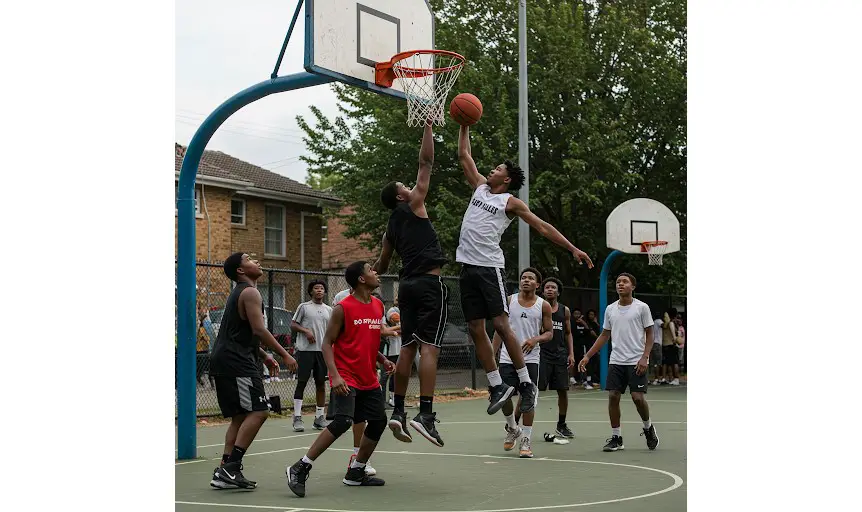
Streetball: A Global Sport Rooted in Passion and Community
Streetball is a thrilling, fast-paced version of basketball played on outdoor courts across the world. Unlike traditional basketball, it thrives on creativity, individual flair, and urban culture. It has evolved into a unique sport with its own rules, style, and community. Its impact spans continents and generations, making it a powerful force in both sport and society. Streetball showcases raw talent, builds strong communities, and reflects cultural identity. It’s more than a game; it’s a movement that continues to grow.
The Origins of Streetball
The roots trace back to the early 20th century in the United States. It began in urban neighborhoods where kids lacked access to gyms or structured leagues. So they played in parks, on driveways, or in alleyways. Basketball hoops were often homemade, and the rules were flexible.
In New York City, courts like Rucker Park became legendary. Talented players from the streets battled each other for bragging rights. Some went on to play professionally, while others became local heroes. Streetball developed its own culture, including music, fashion, and language. It wasn’t just about scoring points. It was about style, confidence, and respect.
During the 1970s and 1980s, hip-hop culture and Streetball grew together. DJs played music courtside while players performed ankle-breaking crossovers. This combination of sport and culture attracted crowds and media attention. It brought Streetball into the public eye.
Global Popularity of Streetball
It spread far beyond the United States. Urban centers around the world embraced it. In cities like Paris, Tokyo, and Manila, young athletes created their own Streetball scenes. Globalization and social media helped popularize the sport internationally.
In Europe, it found a home in countries such as France, Germany, and the United Kingdom. Public parks and community centers became hubs for competition. In Asia, especially in China and the Philippines, the sport exploded in popularity. Players formed teams and participated in local tournaments. China even launched national Streetball events, attracting thousands of participants.
Latin America and Africa are seeing Streetball continue to grow. In Brazil, street courts are filled with talented youth expressing themselves through the sport. In Nigeria and South Africa, it connects young people and offers alternatives to crime and unemployment. Globally, Streetball has become a tool for empowerment.
Amateur Streetball: Youth and Schools
Youth are the heart of Streetball. In many countries, young people play after school or during weekends. They organize pickup games with friends or join informal leagues. These games often have limited supervision. Players negotiate their own rules and resolve disputes on the court.
Schools in some regions have adopted Streetball elements into physical education. Teachers recognize its benefits for physical fitness and teamwork. After-school programs and nonprofits also use Streetball to engage youth. These programs often focus on character development, mentorship, and academic support.
In the United States, AAU and high school basketball sometimes overlap with Streetball. Talented players often participate in both. They bring their creativity from the streets into structured games. In Europe and Asia, similar dynamics exist. Streetball allows players to practice in unstructured environments, improving their skills.
Community tournaments are a cornerstone of amateur Streetball. Local businesses, clubs, or organizations sponsor these events. Winners earn trophies, recognition, or small prizes. However, the main reward is respect and reputation. These games are festive, drawing crowds, DJs, and food vendors. They create a lively atmosphere that celebrates the sport.
Professional Leagues and Organizations
Although Streetball began as an amateur sport, it has inspired several professional ventures. In the early 2000s, the AND1 Mixtape Tour gained fame in the United States. Players with nicknames like “Hot Sauce” and “The Professor” became celebrities. They toured the country, performing tricks and battling local talent.
AND1 matches were televised and drew large crowds. These events blurred the lines between sports and entertainment. Players earned endorsements and appeared in video games. While the original tour ended, its impact remains. Many players transitioned to coaching, social media, or global exhibitions.
Today, professional Streetball leagues exist in various countries. In France, Quai 54 hosts an annual international tournament. Sponsored by Jordan Brand, it features top players from around the world. The event includes music, fashion, and celebrity appearances. It’s one of the most prestigious Streetball events globally.
In China, professional Streetball circuits attract millions of fans. Players compete for contracts and sponsorships. The sport is heavily promoted online, with games streamed to large audiences. In Japan, Taiwan, and the Philippines, local leagues also thrive. These leagues showcase incredible talent and foster community pride.
In Africa, grassroots Streetball leagues are emerging. With support from NGOs and corporate sponsors, players gain opportunities for exposure. These leagues aim to develop skills and create pathways to education or employment.
Streetball’s Political and Social Significance
Streetball is more than entertainment. It holds deep political and social meaning. In many urban communities, the sport provides a safe outlet for youth. Courts serve as gathering places where people form bonds. They create spaces of belonging and identity.
The sport challenges social inequality. It gives a voice to marginalized communities. Through Streetball, players express resistance and resilience. Games often highlight the struggles and triumphs of inner-city life.
In the United States, Streetball has been linked to civil rights movements. Courts like Rucker Park were platforms for social commentary. Athletes used their influence to speak out against injustice. They brought awareness to poverty, racism, and police brutality.
Around the world, Streetball continues this legacy. In Brazil, it connects favelas and builds unity. In South Africa, it fosters racial reconciliation. Young people in Plastine play to assert identity and hope. These examples show how Streetball can inspire change.
Nonprofits and community leaders use the sport to educate and uplift. Programs focus on health, education, and conflict resolution. Many initiatives use Streetball to teach life skills and build leadership. As a result, the sport transforms lives and communities.
Rules of Streetball
Streetball rules vary by region and court. However, some common elements exist. Games are usually played 3-on-3 or 5-on-5. Teams often call their own fouls, promoting honesty and respect. There are no referees in most games.
Games are typically played to a set score or time limit. A common format is “first to 21 points” with 1s and 2s instead of 2s and 3s. Possession changes after each score. A “check ball” at the top of the key restarts play.
There are fewer violations than in formal basketball. Traveling, double-dribbling, and shot clock violations are less strict. Players prioritize flow and creativity over rigid enforcement. Flashy moves and dunks are encouraged.
Despite the informal nature, safety and fairness matter. Players agree on basic rules before starting. Disputes are resolved with do-overs or peer judgment. These customs foster cooperation and mutual respect.
In tournaments, more structured rules may apply. Organizers provide referees, timekeepers, and scoreboards. Still, the spirit of Streetball remains. It emphasizes style, skill, and showmanship over strict adherence to regulations.
The Future of Streetball
Streetball is entering a new era. Technology and media are changing how it’s played and viewed. Players now share highlights on social platforms. These videos attract followers and create opportunities.
Sponsorships and partnerships are growing. Brands recognize the sport’s cultural power. They invest in events, apparel, and endorsements. As a result, it becomes more visible and influential.
Education and development programs are expanding. Schools and nonprofits integrate Streetball into curricula. They promote fitness, discipline, and creativity. These programs build a new generation of players and leaders.
International collaborations are increasing. Tournaments bring together players from diverse backgrounds. They exchange skills, stories, and experiences. These connections strengthen the global Streetball community.
The sport continues to inspire music, fashion, and art. Streetball culture influences design, language, and identity. It reflects the voices of the streets and the dreams of the youth.
Governments and policymakers are beginning to take notice. Investment in courts and facilities is rising. Streetball is seen as a tool for urban development and peacebuilding. It bridges gaps between generations, classes, and cultures.
Conclusion
Streetball is a powerful and dynamic sport that continues to grow. From its humble origins on urban courts to its global impact today, it represents passion, creativity, and resilience. Young people across the world find joy and meaning in the game. Communities unite through shared experiences on the court.
Its blend of culture, sport, and activism makes it unique. Streetball is not just played; it’s lived. As it evolves, its spirit remains rooted in freedom, expression, and connection. This remarkable sport will continue to shape lives and inspire generations to come.





